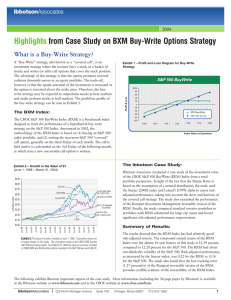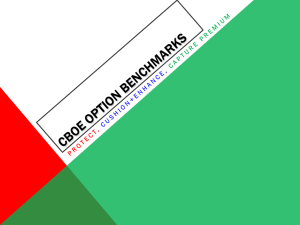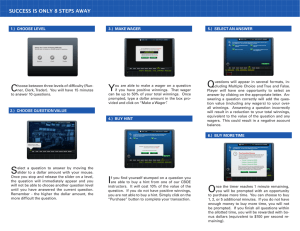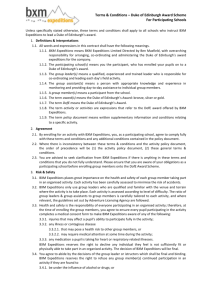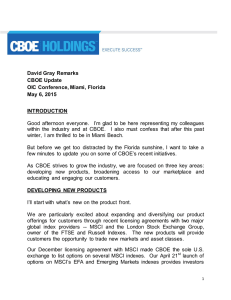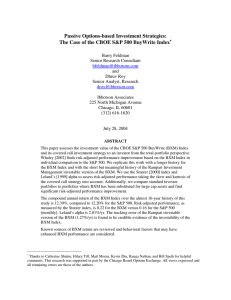The CBOE S&P 500 BuyWrite Index (BXM) A Review of Performance
advertisement
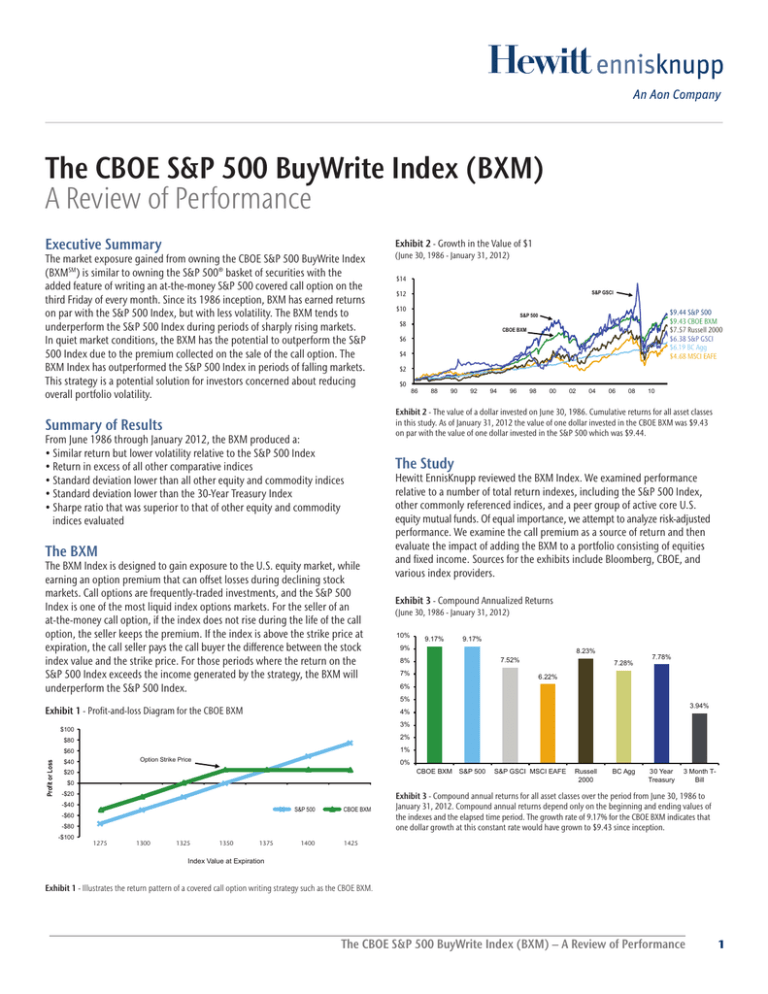
The CBOE S&P 500 BuyWrite Index (BXM) A Review of Performance Executive Summary Exhibit 2 - Growth in the Value of $1 The market exposure gained from owning the CBOE S&P 500 BuyWrite Index (BXMSM) is similar to owning the S&P 500® basket of securities with the added feature of writing an at-the-money S&P 500 covered call option on the third Friday of every month. Since its 1986 inception, BXM has earned returns on par with the S&P 500 Index, but with less volatility. The BXM tends to underperform the S&P 500 Index during periods of sharply rising markets. In quiet market conditions, the BXM has the potential to outperform the S&P 500 Index due to the premium collected on the sale of the call option. The BXM Index has outperformed the S&P 500 Index in periods of falling markets. This strategy is a potential solution for investors concerned about reducing overall portfolio volatility. Summary of Results From June 1986 through January 2012, the BXM produced a: • Similar return but lower volatility relative to the S&P 500 Index • Return in excess of all other comparative indices • Standard deviation lower than all other equity and commodity indices • Standard deviation lower than the 30-Year Treasury Index • Sharpe ratio that was superior to that of other equity and commodity indices evaluated The BXM The BXM Index is designed to gain exposure to the U.S. equity market, while earning an option premium that can offset losses during declining stock markets. Call options are frequently-traded investments, and the S&P 500 Index is one of the most liquid index options markets. For the seller of an at-the-money call option, if the index does not rise during the life of the call option, the seller keeps the premium. If the index is above the strike price at expiration, the call seller pays the call buyer the difference between the stock index value and the strike price. For those periods where the return on the S&P 500 Index exceeds the income generated by the strategy, the BXM will underperform the S&P 500 Index. Exhibit 1 - Profit-and-loss Diagram for the CBOE BXM S&P GSCI $12 $10 $9.44 S&P 500 $9.43 CBOE BXM $7.57 Russell 2000 $6.38 S&P GSCI $6.19 BC Agg $4.68 MSCI EAFE S&P 500 $8 CBOE BXM $6 $4 $2 $0 86 88 90 92 94 96 98 00 02 04 06 08 10 Exhibit 2 - The value of a dollar invested on June 30, 1986. Cumulative returns for all asset classes in this study. As of January 31, 2012 the value of one dollar invested in the CBOE BXM was $9.43 on par with the value of one dollar invested in the S&P 500 which was $9.44. The Study Hewitt EnnisKnupp reviewed the BXM Index. We examined performance relative to a number of total return indexes, including the S&P 500 Index, other commonly referenced indices, and a peer group of active core U.S. equity mutual funds. Of equal importance, we attempt to analyze risk-adjusted performance. We examine the call premium as a source of return and then evaluate the impact of adding the BXM to a portfolio consisting of equities and fixed income. Sources for the exhibits include Bloomberg, CBOE, and various index providers. Exhibit 3 - Compound Annualized Returns (June 30, 1986 - January 31, 2012) 10% 9% 9.17% 9.17% 8.23% 7.52% 8% 7% 7.28% 7.78% 6.22% 6% 5% 3.94% 3% 2% $80 1% $60 Profit or Loss $14 4% $100 Option Strike Price $40 0% CBOE BXM S&P 500 $20 $0 -$20 -$40 1375 -$60 1400 S&P 500 1425 CBOE BXM -$80 -$100 (June 30, 1986 - January 31, 2012) 1275 1300 1325 1350 1375 1400 S&P GSCI MSCI EAFE Russell 2000 BC Agg 30 Year Treasury 3 Month TBill Exhibit 3 - Compound annual returns for all asset classes over the period from June 30, 1986 to January 31, 2012. Compound annual returns depend only on the beginning and ending values of the indexes and the elapsed time period. The growth rate of 9.17% for the CBOE BXM indicates that one dollar growth at this constant rate would have grown to $9.43 since inception. 1425 Index Value at Expiration Exhibit 1 - Illustrates the return pattern of a covered call option writing strategy such as the CBOE BXM. The CBOE S&P 500 BuyWrite Index (BXM) – A Review of Performance 1 Exhibit 4 - Annualized Standard Deviations Exhibit 7 - Summary Statistics for BXM and Other Investments (June 30, 1986 - January 31, 2012) (June 30, 1986 - January 31, 2012) 25.0% 20.72% 20.27% 20.0% 18.02% 15.87% 15.0% 12.18% 11.37% 10.0% 3.98% 5.0% 0.66% 0.0% CBOE BXM S&P 500 S&P GSCI MSCI EAFE Russell 2000 BC Agg 30 Year Treasury 3 Month TBill Exhibit 4 - Annualized standard deviation for all asset classes over the period from June 30, 1986 to January 31, 2012. CBOE BXM has performed in-line with the S&P 500 annulized returns while at a much lower level of volatility. Exhibit 5 - Histogram of Monthly Returns (June 30, 1986 - January 31, 2012) 100 80 CBOE BXM 60 40 S&P 500 S&P GSCI Statistics CBOE BXM S&P 500 Annualized Return Standard Deviation Autocorrection Skew Kurtosis Jensen’s Alpha Sharpe Ratio Sortino Ratio Correlation to S&P 500 9.2% 11.4% 0.10 -1.55 5.85 1.9% 0.46 0.45 0.89 9.2% 15.9% 0.06 -0.78 2.26 0.0% 0.33 0.43 1.00 MSCI EAFE Russell 2000 BC Agg 7.5% 6.2% 20.7% 18.0% 0.17 0.09 -0.21 -0.40 2.26 0.84 2.5% -1.8% 0.13 0.17 0.25 0.18 0.15 0.69 8.2% 20.3% 0.13 -0.90 3.00 -1.2% 0.21 0.27 0.82 7.3% 4.0% 0.13 -0.22 0.54 3.2% 0.84 1.40 0.14 30 Year 3 Month Treasury T-Bill 7.8% 12.2% 0.07 0.25 3.25 4.1% 0.32 0.50 -0.06 3.9% 0.7% 1.00 -0.17 -0.86 0.0 – – 0.06 Exhibit 7 - The BXM index had higher risk-adjusted returns (as measured by the Sharpe ratio and Sortino ratio) than the three stock indices and the S&P GSCI Index, but the BXM and stock indices also had negative skewness in their distributions. Results Over Time We further review the BXM strategy via monthly returns. Rolling five-year annualized BXM returns relative to the S&P 500 Index help demonstrate how closely the two track. The rolling five-year annualized standard deviation of the BXM relative to the S&P 500 Index has remained fairly constant over the last 25 years. At many points through history the BXM’s standard deviation has been approximately two-thirds of the S&P 500 Index. Exhibits 8, 10, and 11 reinforce statements made earlier that the BXM is likely to outperform in down markets, typically do well in quiet markets, and lag in strong bull markets. Finally, we examine the BXM and S&P 500 Index returns during major market events. 20 0 -20% - 15% - 10% - 5% 5% 0% 10% 15% Exhibit 8 - Rolling Five-Year Annualized Returns 20% (June 30, 1986 - January 31, 2012) Monthly Return 30% Exhibit 5 - Empiricial monthly return distribution of the S&P 500 and the CBOE BXM over the period from June 30, 1986 to January 31, 2012. The narrower profile of the CBOE BXM return density illustrates its lower volatility. As noted in Exhibit 7, the skew was -1.55 for BXM and -0.78 for the S&P 500. The kurtosis for the CBOE BXM and the S&P 500 was 5.8 and 2.3, respectively. The S&P 500 saw its worst monthly return in October of 1987 with -21.5% compared with a -17.5% return for the CBOE BXM during the same month. At the peak of the graph, there were 82 months where the CBOE BXM returned between 1% and 3%. 20% 15% 10% 0% (June 30, 1986 - January 31, 2012) -5% -10% 10% Annualized Return (%) S&P 500 BXM 8% 30-Yr Tr BC AGG 7% Russell 2000 92 93 94 95 96 98 99 00 01 02 03 05 06 07 08 09 10 12 Exhibit 8 - Rolling Five-Year Annualized returns for the S&P 500 and the CBOE BXM over the period June 30, 1991 to January 31, 2012. S&P GSCI MSCI EAFE 6% CBOE BXM 5% Exhibit 6 - Risk-Return Tradeoff 9% S&P 500 25% 5% 4% Exhibit 9 - Rolling Five-Year Standard Deviation 3% (June 30, 1986 - January 31, 2012) 2% 25% 1% 0% 0% 5% 10% 15% 20% 25% Annualized Risk (%) Exhibit 6 - Risk-Return Tradeoff of all asset classes under consideration from June 30, 1986 to January 31, 2012. The CBOE BXM has performed in-line with the S&P 500 on an annualized basis with a much lower annualized volatility. 20% S&P 500 18.88% 15% 14.87% 10% 5% 0% CBOE BXM 92 93 94 95 96 98 99 00 01 02 03 05 06 07 08 09 10 12 Exhibit 9 - Rolling Five-Year Annualized Standard Deviation comparison between the S&P 500 and the CBOE BXM from June 30, 1986 to January 31, 2012. The S&P 500 shows higher annualized risk than CBOE BXM for the time period under consideration. 2 Hewitt Ennis Knupp An Aon Company Exhibit 10 - Return Comparison between CBOE BXM and S&P 500 during Extreme Market Environments Exhibit 12 - Implied Volatility (VIX) minus Subsequent S&P 500 Realized Volatility – Average Per Year (2000 - 2012) (June 30, 1986 - January 31, 2012) CBOE BXM 40% S&P 500 22% 20% 6.2 5.5 5.2 19% 19% 14% 14% 2.4 17% 16% 5.6 4.0 4.0 29% 30% 6.0 2.0 0.7 10% 3.0 2.5 1.6 1.2 0.0 0% -10% -5% -7% -4% -6% -8% -20% -2.0 -17% -21% -30% -4.0 2000 -33% -40% Bond Market Rally 10/1/1992 to 1/31/1994 Surpise Fed Rate Hike 2/1/1994 to 3/31/1994 Russia default/ LTCM 5/1/1998 to 8/31/1998 Post-LTCM 9/1/1998 to 12/31/1998 Tech Bubble 1/1/1999 to 3/31/2000 Tech Bust 4/1/12000 to 2/28/2003 Credit Rally 8/1/2002 to 3/31/2004 2001 2002 Credit Crisis 6/1/2007 to 01/31/2009 Exhibit 10 - Return Comparison between the CBOE BXM and the S&P 500 during extreme market environments in the last two decades. The CBOE BXM outperformed the S&P 500 during most extreme market conditions except the Post-LTCM period. Exhibit 11 - CBOE BXM and S&P 500 Returns and Universe Rankings Comparison during Extreme Market Conditions 2003 2004 2005 2006 2007 -3.1 2008 2009 2010 2011 2000 2001 2002 2003 2004 2005 2006 2007 2008 2009 2010 2011 Implied Volatility 23.0 25.4 26.7 21.7 15.3 12.7 12.7 17.5 32.8 31.4 22.7 24.0 Realized Volatility of S&P 500 22.2 20.2 25.5 16.3 11.3 10.39 9.7 16.0 35.9 25.2 17.0 21.5 Exhibit 12 - Estimated average per year of the spread between end-of-week values for VIX and for subsequent 30-trading-day historic volatility for S&P 500. The difference between the implied and the realized volatility is a risk premium earned by the investor. Exhibit 13 - 12-Month Gross Premium Income Earned vs. CBOE BXM Return (May 31, 1989 - January 31, 2012) 60 50 CBOE BXM S&P 500 30 20 10 0 -10 29.1% (50) 22.2% (92) 14.3% (85) 14.2% (85) -4.8% (11) -7.0% (77) 60% 19.3% (49) 18.6% (53) 40% 16.8% (38) 15.6% (52) 29.1% 20% 6.1% 0% -3.7% (1) -7.9% (2) -5.5% (17) -16.8% (88) -20 -30 -40 80% -20% -40% -21.2% (14) -32.7% (94) 89 91 93 95 97 99 01 Tr ailing 12-Month Income (Premium) Bond Market Rally 10/1/1992 to 1/31/1994 Surpise Fed Rate Russia default/LTCM Post-LTCM 9/1/1998 Hike 2/1/1994 to 5/1/1998 to to 12/31/1998 3/31/1994 8/31/1998 Tech Bubble 1/1/1999 to 3/31/2000 Tech Bust 4/1/12000 Credit Rally 8/1/2002 to 2/28/2003 to 3/31/2004 Credit Crisis 6/1/2007 to 01/31/2009 Exhibit 11 - The CBOE BXM and S&P 500 returns and universe ranking comparison during extreme market conditions. Historical rankings are based on the U.S. Large Cap Core Equity manager universe data provided by eVestment Alliance. Average number of managers included in the universe under consideration was 170. During extreme down markets the CBOE BXM has consistently outperformed the S&P 500, which is depicted by the higher ranking of the CBOE BXM. Looking at the recent Credit Crisis, the CBOE BXM outperformed the S&P 500 by 11.5 percentage points and was ranked in the top 15th percentile while S&P 500 ranked among the bottom 90th percentile. The Call Premium – A Significant Source of Return Selling an at-the-money call option each month earned an average gross premium of 1.8% of the notional value of the S&P 500 Index, which averages 21.6% per year. There is substantial variation of the premium income that can be earned by this strategy. The premium earned by selling call options can reduce the negative impact of falling markets. A significant source of return to this strategy comes from the tendency of index options to trade at prices above their fair value. As the demand for index options is high, and the natural number of options sellers is low, the buyers of options tend to pay a premium. Essentially, the implied volatility tends to be at a higher level than realized volatility. Sellers of index options, over long periods of time, earn this risk premium of the excess of implied over realized volatility as compensation for selling volatility. 03 05 07 09 11 Trailing 12-Month CBOE BXM return Exhibit 13 - The gross premiums earned by the BXM Index have averaged about 1.8% per month, or more than 21% per year. The issue of whether the net returns of the BXM Index can match gross premiums often is related to the severity of monthly declines in the S&P 500 Index. For example, in the year 1995 the S&P 500 Index had only one monthly decline (0.5%), and the BXM Index rose 21% that year. On the other hand, in 2008 the S&P 500 Index declined by 6% or more in five different months (and was down 37% for the year), while the BXM Index was down 29% for the year. Adding BXM to a Portfolio We examine the impact of adding up to 15% of the BXM Index to a standard portfolio consisting of U.S. bonds and global equity. Historical returns were used to construct the efficient frontiers. Exhibit 14 - Expansion of the Mean-Variance Efficient Frontier when CBOE BXM is added to the Asset Mix of U.S. Bonds and Global Equity (June 1, 1986 - January 31, 2012) Expected Nominal Geometric Return Rate of Return (%) 40 8.0% With CBOE BXM Without CBOE BXM 7.5% 7.0% 3% 4% 5% 6% 7% 8% 9% 10% 11% 12% 13% Expected Risk Exhibit 14 - Mean-Variance Efficient Frontier expands when the CBOE BXM is added to the asset mix of U.S. Bonds and Global Equity. U.S. bonds are represented by the Barclays Capital U.S. Bond Aggregate Index and global equity is represented by MSCI All Country World Index. The Efficient Frontier is constrained to a maximum 15% allocation the CBOE BXM. The CBOE S&P 500 BuyWrite Index (BXM) – A Review of Performance 3 Multiple products, passive and active, track the BXM Index. For the purposes of this study, we examine two passive exchange-traded investment vehicles, the Powershares S&P 500 BuyWrite Portfolio ETF (PBP) and the iPath CBOE S&P 500 BuyWrite exchange-traded note (BWV). Our goals are to sample how well passive products track the underlying BXM Index and to make comparisons with the SPDR S&P 500 (SPY) ETF. Since December 2007, the PBP and the BWV have produced an annualized tracking error of 0.7% and 0.3% versus the BXM Index, respectively. Exhibit 15 - Investable Instruments and Supplementary Statistics Since Year-End 2007 (December 31, 2007 - January 31, 2012) Statistics Annualized Return Standard Deviation Autocorrection Skew Kurtosis Jensen’s Alpha Correlation to S&P 500 BWV ETN PBP ETF SPY ETF -0.19% 16.5% 0.24 -0.85 1.44 0.10% 0.91 -1.51% 16.3% 0.25 -0.92 1.60 -1.23% 0.91 -0.58% 20.5% 0.24 -0.49 0.11 -0.04% 1.00 CBOE BXM S&P 500 0.47% 16.3% 0.24 -0.88 1.54 -0.75% 0.91 -0.54% 20.5% 0.24 -0.49 0.10 0.00% 1.00 Exhibit 16 -Estimate of the Delta-adjusted (0.5) Notional $ Value of Average Daily Volume for S&P 500 Options (January 31, 2001 - January 31, 2012) $73,000 $63,000 ($ in Million) Evidence of Investability $53,000 $43,000 $39.9 billion $33,000 $23,000 $13,000 $3,000 01 02 03 04 05 06 07 08 09 10 11 12 Exhibit 16 - Estimate of Delta-adjusted (0.5) notional $ value of S&P 500 options based on Average Daily Volume per month. The notional amount of S&P 500 options being traded on a daily basis has grown exponentially during the past decade.In the five-year period from 2007 through 2011, the average daily volume for S&P 500 Index options was around 700,000 contracts for a delta-adjusted notional value of approximately $40 billion. The deltas for options contracts can range from 0 to 1. Exhibit 15 - After the 2002 introduction of the BXM Index, many investors inquired about investability of the index, and dozens of actively managed buywrite products were launched in the past decade. In 2007 two exchange-traded products (ETPs) designed to try to match the BXM Index were introduced – the PowerShares S&P 500 ButWrite Portfolio ETF (PBP) and the iPath CBOE S&P 500 BuyWrite Index exchange-traded note (BWV). Both of these products have expense ratios of 0.75% that are factored into the returns above. The standard deviation for the PBP and BWV is about 4 percentage points lower than the SPY standard deviation. Please read the ETP prospectus for information about investment risk, counterparty risk, and expenses. This paper was prepared by Hewitt EnnisKnupp at the request of Chicago Board Options Exchange, Incorporated (CBOE). CBOE provided financial support for this paper. The BXM Index is designed to represent a hypothetical strategy. The actual performance of investment vehicles such as mutual funds can have significant differences from the performance of hypothetical indices. Investors attempting to replicate the BXM Index should discuss with their advisors possible timing and liquidity issues. Past performance does not guarantee future results. This paper contains index performance data based on back-testing, i.e., calculations of how the index might have performed prior to launch. Back-tested performance information is purely hypothetical and is provided in this paper solely for information purposes. Index returns do not reflect management fees, transactions costs or expenses. Nothing in this paper should be deemed as investment advice or a recommendation by Hewitt EnnisKnupp or CBOE to buy or sell securities. Neither Hewitt EnnisKnupp nor CBOE assumes any responsibility for any losses you might suffer by reason of adopting any investment strategy discussed in this paper. CBOE®, Chicago Board Options Exchange® and VIX® are registered trademarks and BuyWrite and BXM are service marks of CBOE. CBOE calculates and disseminates the BXM Index. The methodologies of the BXM Index is owned by CBOE and may be covered by one or more patents or pending patent applications. Standard & Poor’s®, S&P®, and S&P 500® are registered trademarks of Standard & Poor’s Financial Services, LLC and are licensed for use by CBOE. CBOE’s options based on S&P 500 indexes and financial products based on the BXM Index are not sponsored, endorsed, marketed or promoted by Standard & Poor’s and Standard & Poor’s makes no representations regarding the advisability of investing in such products. About Hewitt EnnisKnupp Hewitt EnnisKnupp, Inc., an Aon company, provides investment consulting services to over 460 clients in North America with total client assets of over $2 trillion. Our 238 investment consulting professionals, a result of the merger of Hewitt Investment Group, Ennis, Knupp & Associates, and Aon Investment Consulting advises clients ranging in size from $3 million to over $740 billion and includes endowments, foundations, corporate and public pension plans. or more information, please visit www.aonhewitt.com. 4 Hewitt Ennis Knupp An Aon Company Copyright Hewitt EnnisKnupp 2012. All Rights Reserved.
